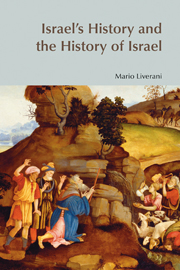Book contents
- Frontmatter
- Dedication
- Contents
- List of Tables and Illustrations
- Foreword
- Abbreviations
- IMPRINTING
- Part I A NORMAL HISTORY
- INTERMEZZO
- Part II AN INVENTED HISTORY
- EPILOGUE
- Chapter 19 LOCAL HISTORY AND UNIVERSAL VALUES
- Bibliography
- Index of References
- Index of Names of Persons and Deities
- Index of Placenames
Chapter 19 - LOCAL HISTORY AND UNIVERSAL VALUES
from EPILOGUE
- Frontmatter
- Dedication
- Contents
- List of Tables and Illustrations
- Foreword
- Abbreviations
- IMPRINTING
- Part I A NORMAL HISTORY
- INTERMEZZO
- Part II AN INVENTED HISTORY
- EPILOGUE
- Chapter 19 LOCAL HISTORY AND UNIVERSAL VALUES
- Bibliography
- Index of References
- Index of Names of Persons and Deities
- Index of Placenames
Summary
The Fourth-Century Scenario: The ‘Second Temple’ and the Diaspora
Just as it proved difficult to set a date for the beginning of this ancient history of Israel, it is equally difficult to establish a final date. This history is not contained between two dates, or two events, but rather between two processes, each lasting a given period of time. The process involving so-called ‘ethnogenesis’ began with the invasion of the ‘Sea Peoples’ in about 1180 and lasted for a couple of centuries, though it was rooted in the socioeconomic and political situation of the Late Bronze Age. The beginning of the twelfth century as the crucial turning point and founding moment, not only for the kingdoms of Judah and Israel but for all Levantine political formations at the beginning of the Iron Age seems therefore reasonable as well as widely shared choice.
Taking the early-fourth century – let us use 398 as a symbolic date – as the final date for our history requires more explanation. Ezra's mission (which can be precisely dated to 398, despite a number of problems) represents another appropriate turning point, the beginning of Judaism. The finalization of the drafting of the Law, the end of prophetism, the end of Deuteronomistic historiography, the rise to power of the priesthood in Jerusalem, national self-identification based on religion rather than politics – these are all interlinked phenomena, which were to develop and continue at least until the destruction of the ‘second temple’ in 71 CE.
- Type
- Chapter
- Information
- Israel's History and the History of Israel , pp. 363 - 368Publisher: Acumen PublishingPrint publication year: 2005

